Córdoba has been, at varying times throughout history, an Iberian city, home to the Roman temple, the largest city in the world, an Islamic capital, and an intellectual axis in European history. The city today is as diverse as its accomplishments just as visitors will find a Moorish Museum across from a Catholic Church that once served as a Mosque.
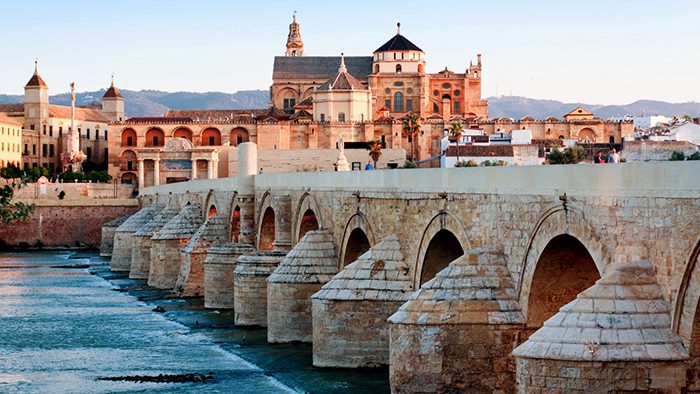
The first humans to wander about modern day Spain were Neanderthals, who made their home here some 33,000 years ago. In the 8th century B.C., Spain’s ancient inhabitants learned metallurgy, mostly with copper and silver. This eventually would draw friend and foe alike, across land and sea in pursuit of this kind of wealth.
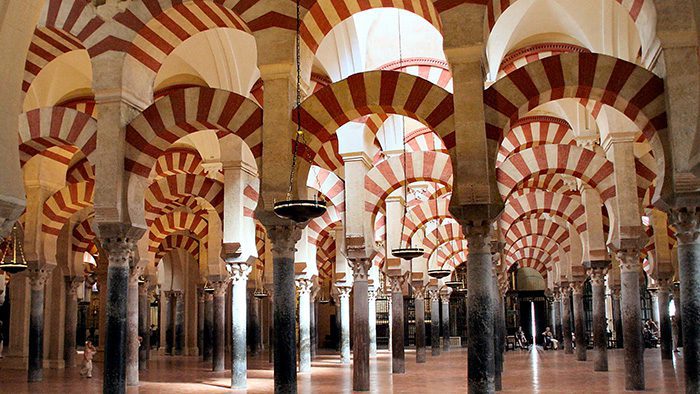
It was ultimately Julius Caesar who seized control of the city around 70 B.C. and made it capital of the Roman province of Hispania Ulterior Baetica. It produced several philosophers and poets during this period until the Roman Empire collapsed, at which time it became part of the Byzantine Empire as the capital of the Provincia Hispaniae. This lasted until the 6th century, when it fell to Visigoth forces.

In 711, an Arab Muslim army overran the city. Five years later it became a provincial capital, and another 50 years would see it as the capital of the independent Muslim Emirate of Al-Andalus. It was considered one of the greatest cultural and intellectual centers of its time, with a population of roughly 500,000, and the largest library in the world, which housed 600,000 volumes (impressive when you begin to realize that they were written by hand.) Many considered the Andalusia province to be one of Spain’s dullest, but Córdoba and its storied history is the jewel that forces them to eat humble pie.

Córdoba is located in a valley along the Guadalquivir River and unfortunately its geography dictates its scorching summer temperatures. Córdoba is literally the hottest city in all of Europe during the summer- with temperatures of around 98° Fahrenheit in July and August. The plus side: winter temperatures almost never dip below the 40’s, making it a great destination to visit all year round, with the optimal times being April, May and October. Here are my top 15 things to see and do in Cordoba, Spain.

This sacred site, at one time one of the most important temples in Córdoba, was discovered through a decidedly ungodly method: during an expansion of the City Hall during the 1950’s. Architects stumbled across this ancient masterpiece and immediately halted the project. An inquiry into the temple unearthed an indubitably rich history. Roman Caesar Augustus gave the area in and around modern-day Córdoba to war veterans after the annihilation of General Pompey and his forces. He named the area Colonia Patricia. Those grateful and loyal patriots built this temple as homage to their generous ruler Augustus.
Five decades after it was built, historians knew that construction began between 41-54 A.D., and ended some 40 years later, between 81-96 A.D. This Corinthian-style temple consisted of 6 frontal columns, and 10 on each side- all resting on a podium. Today a handful of the columns, the stairs, and the podium are still intact. The true value of this temple lies in the fact that the most skilled craftsmen in the Roman Empire constructed it almost completely out of marble. This makes it a completely one of a kind specimen, unrivaled across the world.

Built during the first century, the Roman Bridge spans the Guadalquivir River and was a major roadway during Córdoba’s heyday in the 10th and 11th centuries. The bridge has been renovated several times, most recently in 2007, and the only remnants of the original structure are the antique foundations. On one end of the bridge is the Calahorra Tower and at the other is the entrance to the bridge, the Puerta del Puente, which was built in 1572.
In the middle of the bridge is a small shrine and a statue of St. Raphael, which was carved in 1651 by Bernabe Gomez del Rio. Devotees often burn candles in front of the statue. Walking across the span of this bridge is a great way to see the sights of Córdoba from a distance and enjoy the Spanish community.
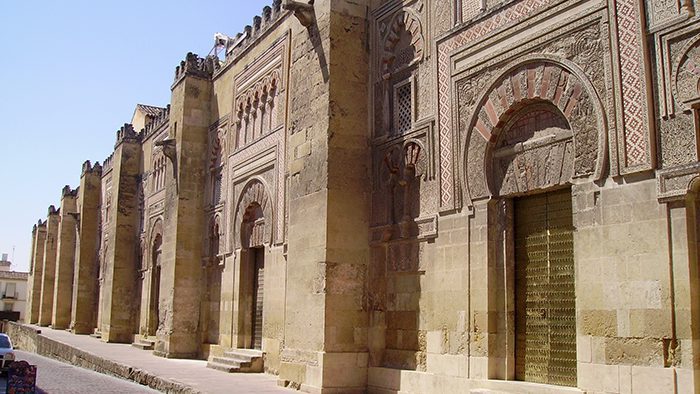
Of all the things to see and do in Córdoba, this is the #1! La Mezquita is a stunning UNESCO World Heritage Site that is notable for its elegant architecture and prolific history. The building began as the Visigoth church of St. Vincent, built in the year 600. After Islamic forces conquered the Visigoths, the church was split between the Muslim and Christian worshipers. The exiled Umayyad prince Abd ar-Rahman I eventually became the governor over the region and allowed the Christians to rebuild many of their demolished churches.
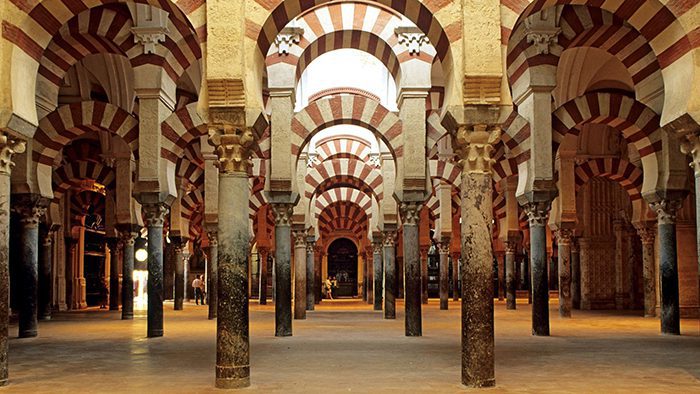
Ar-Rahman purchased the Christian half of the Visigoth’s former church and converted the entire building into Aljama Mosque. The mosque was named for Ar-Rahman ‘s wife and served as extension of the palace. It was continuously renovated until 987. After the Spanish Reconquista, the mosque was converted to a Roman Catholic Church, with a plateresque cathedral being added to the center of the building.
The most striking feature of the church is the gigantic arches, which consist of 856 columns decorated with onyx, granite, jasper, and marble. They were constructed out of the remnants of a Roman building. The Dome of the Rock inspired the red and white voussoirs on the arches. La Mezquita is open daily. Entrance fee is 8 Euros for adults and 4 Euros for children.

The Judería, Córdoba’s Jewish quarters, is an intriguing maze of narrow alleys, small town merchants and the ambiance of a forgotten time. The Judería extends from the Calle El Rey Heredia in the northeast to La Mezquita in the south. The quarters are all that remains of the thriving Jewish and Arab population that was evicted in the 1400s. La Puerta de Almodavar, also known as the Gate of Almodovar, marks the entrance to the quarters and includes a statue of Seneca.
The famous Jewish philosopher and author Maimonides, was born in Córdoba in 1125 and a statue of him can be found in the Tiberiadus Square. On Calle de los Judíos, the Street of the Jews, is the ancient synagogue that was frequented by Córdoba’s Jewish population.
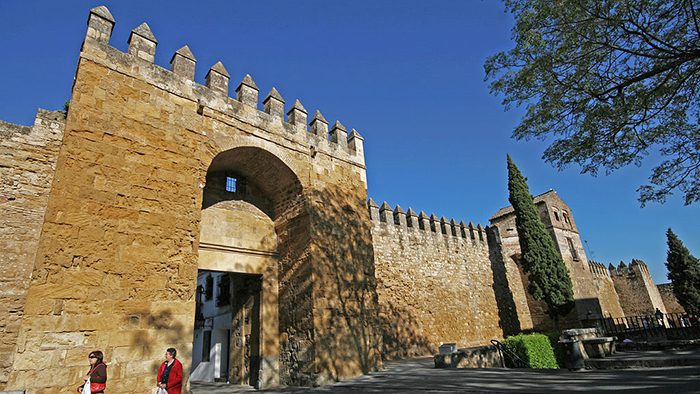
These majestic gates of Arab origin usher visitors into the city’s Jewish Quarter. The Gate of Almodovar was just one of seven entrances to the ancient Corduba Colonia Patricia. The gate itself consists of an arch, superimposed over a box. The wall into which the gate is embedded extends for a few miles in either direction; tourists with some free time might want to go for a walk along these ancient strongholds. It is an excellent way to get just a glimpse of Córdoba’s rich history, and the path is lined with friendly vendors and locals. In a small nearby square visitors will find a statue of Seneca, a Roman philosopher, statesman, and poet who served as Emperor Nero’s personal tutor.

The circular Roman Mausoleum, discovered in 1993 during an archeological dig, was built in the first century and was designed by an Italian architect to reflect the imperial mausoleums found in the Roman capital. The mausoleum consists of a burial chamber, and remnants of what used to be the battlements, the basement, and the cornices. It was discovered during a 1993 archeological dig. The mausoleum is an example of an ancient Roman law that mandated burials on the outskirts of a city or on the sides of the roads. Although hundred of Roman Mausoleums have been discovered buried and dilapidated around Europe, the one in Córdoba is in excellent condition and out in the open for all to see.

The Archeological Museum of Córdoba features a wide range of artifacts from a multitude of time periods, all of which have been found in Córdoba and the surrounding areas. The building in which the museum is located can be found in the historical quarter of Córdoba, which is a UNESCO World Heritage Site. The collection was moved several times until it found its current home in the city’s historical center. The museum includes six halls and four courtyards that cover everything from Roman, Muslim and Visigoth cultures to architecture and burial structures. Its collection includes ancient mosaics, sculptures, religious items, pottery, masks, and jewelry. There is a wealth of information about Córdoba’s past to be experienced here and this is mandatory stop for those looking to learn more about this culturally rich city. The museum also hosts modern art, ceramics, and other specialty exhibits throughout the year. Admission is free for E.U. members. For all others is 1.50 Euros admission. The museum is closed on Mondays.

For a couple of Euros and some change you can step through time and inside Casa Andalusi, a quaint 12th century home that reflects Córdoba’s Islamic legacy. Tour the ground floor, the courtyards and the basement and enjoy the detailed mosaics, the blossoming plants, and Moorish décor and architecture. Several exhibits provide information about the Muslim culture in medieval Córdoba and a shop offers a collection of North African trinkets. Inside you will also find a mini paper museum where you will learn how plant paste is processed into sheets of usable paper. This is a gorgeous and informative attraction that will leave you awed at the cultural influence of Córdoba’s Muslims history. It is a must-see.
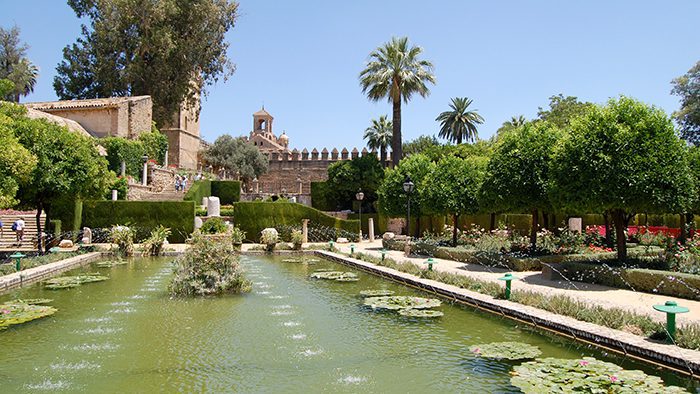
Spanish for the Alcazar of the Christian monarchs, the Alcazar de los Reyes Cristianos is a Moorish-style fortress that was once the home of Isabella I of Castile and Ferdinand II of Aragon. It can be found near La Mezquita and the Guadalquivir River. Originally built by the Visigoths, the fortress changed hands several times over the subsequent hundreds of years, with each owner leaving a distinctive mark. The Moors expanded the fortress to include gardens, baths, and the largest library of its time. Watermills in the Guadalquivir River were used to irrigate the gardens. Alfonso XI of Castile repaired the extensive damage caused by the armies of the Spanish Reconquista. Henry IV of Castile added the main tower and made the fortress compatible with use of gunpowder.
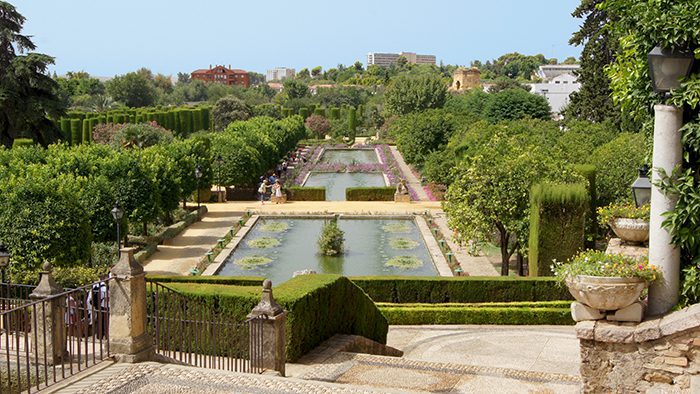
Isabella I of Castile and Ferdinand II of Aragon used the fortress as a tribunal for the Spanish Inquisition. The baths and other areas were converted into dungeons and torture chambers. In 1810, Napoleon Bonaparte used the fortress to house his troop and by 1821, the fortress was used as a prison by the Spanish government. Finally (and thankfully) this mini paradise with a somewhat dark history was converted into a tourist attraction and later into a Spanish national monument. To this day, the gardens and mosaics are still a sight to behold, as is the panoramic view from the towers. The museum is closed on Mondays. Adults entrance fee is 4 Euros, student fee is 2 Euros with I.D., and there is no admission fee on Fridays.
Info: 2 Blocks southwest of the La Mezquita

Bodega Mezquita is the original location and just one of three branches of the popular restaurant Bodega, which serves up a variety of tapas, which are the Spanish equivalent of appetizers. As the name suggests, Bodega Mezquita is located across from the famous Mezquita. Bodega Mezquita opened its doors in 1998 and has since been creating fresh dishes and tapas for the locals and tourists of Córdoba.
I dined on one of their signature menu options: Six tapas from a 40+ tapas list. The food is prepared daily in all its Spanish traditional glory: fried, baked, sautéed, and drizzled with the almighty extra virgin olive oil. The taste of the tapas is truly beyond words, and must be eaten to be understood. You’d be hard pressed to find a bad restaurant in Spain, but you’d be even harder pressed to find one on par with Bodega Mezquita-a place where the sum of the parts really is greater than the whole. Our recommendations: Gazpacho, Oxtail, fried eggplant slices, Pedro Jimenez sweet red wine (Andalucía)

Located at the end of the Roman Bridge is the sun-bleached Calahorra Tower, which was built in the late 12th century to protect the bridge. It originally consisted of two square towers with an arched gate between them. A third tower was added in 1369 by Henry II of Castile. The museum inside is quirky at best, but there are gorgeous views of the city from the top. Enjoy the unique architecture of the tower but the museum itself is not necessarily worth the visit. Audio tours are available. Admission is 4.50 Euros and children under 8 are free.

In the Judería, a few steps away from La Mezquita, is Calleja de las Flores, or Flower Alley. This little side street decorated with red and pink geraniums is at an intersection on the street Velázquez Bosco. It is completely bedecked in bright flowers and is a peaceful place to relax after a day of sightseeing. Keep heading up the street and away from La Mezquita to discover a small teahouse that offers some great brews. When the flowers are in bloom, this winding road will captivate you and make you reluctant to leave its charming path. Keep your eye on the rooftops and snap a great picture of the Mezquita’s tower peering through the cracks.

Cristo de los Faroles, or the Christ of the Lanterns, is an 18th century Baroque sculpture that was carved by Friar Diego José de Cádiz prior to his entrance into the Capuchin-Franciscan Order. The statue itself is a stone cross with an engraving of crucified Christ and is cordoned off by small railings decorated with eight glass street lamps. Candles and flower offerings almost always surround the statue. Located in the Plaza of the Capuchins, the statue was originally called Cristo de los Desagravios y Misericordia, Spanish for Christ’s atonement and mercy. It was later popularly renamed as Cristo de los Faroles in representation of the lanterns that surround the statue. It has been the subject of countless songs, including one by Antonio Molina that was turned into a film in 1958. The gorgeous plaza is also a great place to simply stroll around.

Priego de Córdoba is an enchanting town tucked away in southern Spain. Filled with religiously influenced architecture, ranging from chapels to churches, the town gives visitors an up close look at the spiritual undertones that run deep throughout Spain. To get there head south from Córdoba on highway A-45 and then by taking the A-318 east for 4 km until A-339 east. In about 12 kilometers on the A-339 east you will be in Priego de Córdoba. If you prefer not to drive yourself there are buses available 7 days a week from Córdoba.
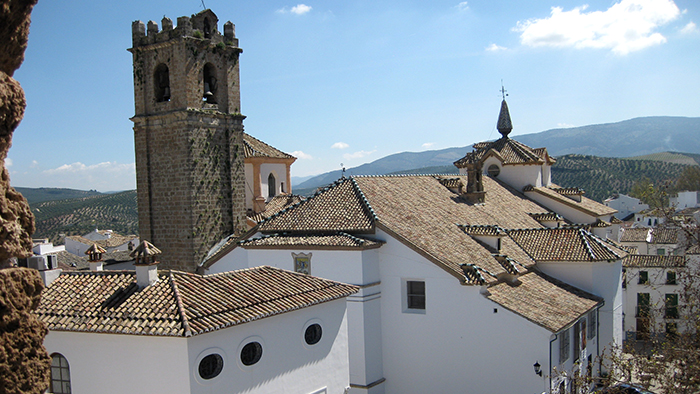
The oldest church in the city was built in the 13th century and looms over the city to this day. The most notable building in town is a Moorish castle being rebuilt from its ruins. Following its capture by Christian armies in 1225, it traded hands twice more before being captured by Alfonso XI in 1340. The castle and the land surrounding it were heavily sought after. The cliff overlooking the town provided ideal natural protection for a fort, and the castle was not far from the Guadajoz River, which has been a key strategic river across Spanish history.

Today, the cliff and river serve more serene purposes, with the river providing good fishing, and the cliff an 180o panoramic view of the town.

Beneath the intimidating architecture, visitors will find many religiously affiliated brotherhoods, some dating back to the 12th century, and all deeply connected with the town’s history. If you are fortunate enough to be visiting on Holy Thursday or Holy Friday, you will witness a massive town-wide procession commemorating those days. Also not to be missed is the local olive oil, which has received multiple accolades at the international level.
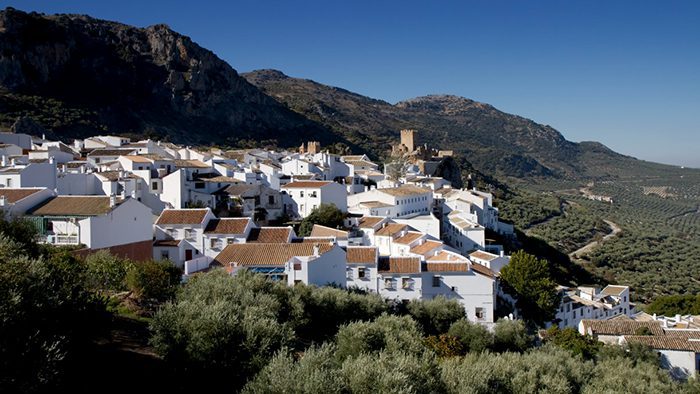
Zuheros is a picturesque town nestled high in the mountains of southern Spain. A trip outside of the town will reveal multiple hiking trails, some of which eventually lead to mountain climbing. Most trails however, lead to a small protrusion off the side of a mountain, which is an excellent place to sit and absorb the natural beauty of the Andalusian countryside, which is renown for its supreme olive oil products. Zuheros can be easily visited by car from Córdoba by taking highway A-45 out of the city until you reach the A-318 east. By staying on the A-318, the highway will continue north and you will see an exit to your right for Zuheros in about 15 kilometers. The landscape is mountainous, but scenic.

The most noted feature is the nearby Murcielago Cave, literally translating into Bat Cave. The walk there is considered to be one of the most scenic in Spain, offering panoramic views of the surrounding landscape. The cave itself is exactly what the name would suggests, a cave of bats. Though not for the meek, the cave is home to many species of bat, and is an ideal cave for spelunking (the sport of exploring caves also known as ‘caving.’) The cave is also home to some of the oldest cave paintings in Europe. Many artifacts have been found in the area, and it is widely considered one of the most significant Neolithic sites in Europe.

Zuheros is a small town with only about 820 local inhabitants, all of whom welcome tourists with open arms. This town is a true taste of the Spanish countryside, and makes a delightful break from a busy city like Córdoba.

Córdoba is essentially a long juicy story about a city’s highs and lows throughout the ages. That story does however, have some sad endings. Visitors can now fortunately visit the abandoned Jewish Quarters and La Mezquita, but while walking through the streets I never once forgot of the people who cherished this city well before the Roman Empire took it as its own. Thankfully now this city has a happy ending. The uniqueness of the Moorish-Spanish culture can be found everywhere you look- in the traditional clothes, music, and especially in the food. I would suggest that you not visit during Holy Week if you want to visit all the city’s attractions because local businesses shut down or have restricted hours during that time. La Hospedería El Churrasco has unrivaled customer service and an unbeatable location. Its restaurant definitely knows how to prepare a succulent steak. I sincerely hope you enjoy this Flamenco loving city in all its glory. I recommend that you visit La Mezquita in the morning so you can take your time inside without hoards of people. As for the Roman Bridge, you will enjoy it more if you visit either in the morning or late afternoon (less crowds and less sun.) Córdoba, although small, packs a great deal of historical significance. The neighboring towns of Priego de Córdoba and Zuhuelos are great day trip options to get you out into the country, which is just what the doctor ordered.

If you have any suggestions about things to see and do in Cordoba, leave a comment below!
Counter
101 Countries • 1432 Cities